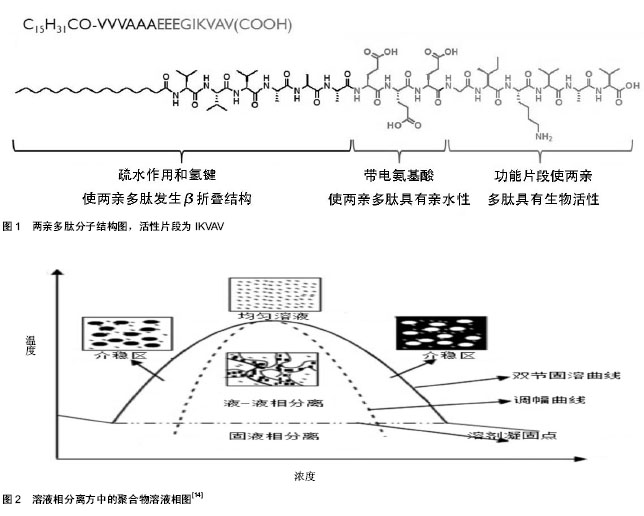| [1] Engler AJ,Sen S,Sweeney HL,et al.Matrix elasticity directs stem cell lineage specification.Cell.2006;126(4):677-689.
[2] Smith LA,Liu X,Hu J,et al.Enhancing osteogenic differentiation of mouse embryonic stem cells by nanofibers. Tissue Eng Part A.2009;15(7):1855-1864.
[3] Martino S,D'Angelo F,Armentano I,et al.Hydrogenated amorphous carbon nanopatterned film designs drive human bone marrow mesenchymal stem cell cytoskeleton architecture.Tissue Engineering Part A.2009;15(10): 3139-3149.
[4] Kopp HG,Avecilla ST,Hooper AT,et al.The bone marrow vascular niche: home of HSC differentiation and mobilization.Physiology (Bethesda).2005;20:349-356.
[5] Branden C,Tooze J.Introduction to protein structure. Ed. Garland New York, 1991.
[6] Whitesides GM,Grzybowski B.Self-assembly at all scales. Science.2002; 295(5564):2418-2421.
[7] Stupp SI.Introduction:functional nanostructures.Chem Rev. 2005; 105(4):1023-1024.
[8] Lehn JM.Supramolecular chemistry:from molecular information towards self-organization and complex matter. Rep Prog Phys.2004;67:249.
[9] Israelachvili JN.Intermolecular and surface forces. Ed. Academic press,2011.
[10] Zhang S,Holmes T,Lockshin C,et al.Spontaneous assembly of a self-complementary oligopeptide to form a stable macroscopic membrane.Proc Natl Acad Sci USA.1993;90(8): 3334-3338.
[11] Silva GA,Czeisler C,Niece KL,et al.Selective differentiation of neural progenitor cells by high-epitope density nanofibers. Science.2004;303(5662): 1352-1355.
[12] Zhang S,Greenfield MA,Mata A,et al.A self-assembly pathway to aligned monodomain gels.Nat Mater. 2010; 9(7):594-601.
[13] Ma PX,Zhang R.Synthetic nano-scale fibrous extracellular matrix. J Biomed Mater Res.1999;46(1):60-72.
[14] Yang F,Murugan R,Ramakrishna S,et al.Fabrication of nano-structured porous PLLA scaffold intended for nerve tissue engineering.Biomaterials.2004;25(10): 1891-1900.
[15] Liu X,Ma PX.Phase separation,pore structure, and properties of nanofibrous gelatin scaffolds.Biomaterials. 2009;30(25): 4094-4103.
[16] Greiner A,Wendorff JH.Electrospinning:a fascinating method for the preparation of ultrathin fibers.Angew Chem Int Ed Engl. 2007; 46(30): 5670-5703.
[17] Dersch R,Liu T,Schaper AK,et al.Electrospun nanofibers: Internal structure and intrinsic orientation.J Polym Sci Part A: Polym Chem.2003;41(4):545-553.
[18] Li WJ,Tuli R,Huang X,et al.Multilineage differentiation of human mesenchymal stem cells in a three-dimensional nanofibrous scaffold. Biomaterials.2005;26(25): 5158-5166.
[19] Ohkawa K,Cha D,Kim H,et al.Electrospinning of chitosan. Macromol Rapid Commun.2004;25(18):1600-1605.
[20] Kidoaki S,Kwon IK,Matsuda T.Mesoscopic spatial designs of nano- and microfiber meshes for tissue-engineering matrix and scaffold based on newly devised multilayering and mixing electrospinning techniques.Biomaterials.2005;26(1): 37-46.
[21] Um IC,Fang D,Hsiao BS,et al.Electro-spinning and electro-blowing of hyaluronic acid. Biomacromolecules. 2004; 5(4):1428-1436.
[22] Neal RA,McClugage III SG,Link MC,et al.Laminin nanofiber meshes that mimic morphological properties and bioactivity of basement membranes.Tissue Eng Part C Methods. 2008; 15(1):11-21.
[23] Mao HQ,Lim SH,Zhang S,et al.The Nanofiber Matrix as an Artificial Stem Cell Niche.Biomaterials as Stem Cell Niche, Studies in Mechanobiology Tissue Engineering and Biomaterials. 2010;2:89-118.
[24] Stevens MM,George JH.Exploring and engineering the cell surface interface. Science.2005;310(5751):1135-1138.
[25] Hackney JA,Charbord P,Brunk BP,et al.A molecular profile of a hematopoietic stem cell niche.Proc Natl Acad Sci USA. 2002;99(20):13061-13066.
[26] Nishikawa M,Tahara T,Hinohara A,et al.Role of the microenvironment of the embryonic aorta-gonad-mesonephros region in hematopoiesis. Ann N Y Acad Sci.2001; 938:109-116.
[27] Bagley J,Rosenzweig M,Marks DF,et al.Extended culture of multipotent hematopoietic progenitors without cytokine.Exp Hematol.1999;27(3):496-504.
[28] Li Y,Ma T,Kniss DA,et al.Human cord cell hematopoiesis in three-dimensional nonwoven fibrous matrices: in vitro simulation of the marrow microenvironment. J Hematother Stem Cell Res.2001;10(3):355-368.
[29] Nur-E-Kamal A,Ahmed I,Kamal J,et al.Three-dimensional nanofibrillar surfaces promote self-renewal in mouse embryonic stem cells.Stem Cells.2006;24(2): 426-433.
[30] Shih YR,Chen CN,Tsai SW,et al.Growth of mesenchymal stem cells on electrospun type I collagen nanofibers.Stem Cells.2006;24(11):2391-2397.
[31] Hosseinkhani H,Hosseinkhani M,Tian F,et al.Osteogenic differentiation of mesenchymal stem cells in self-assembled peptide-amphiphile nanofibers. Biomaterials. 2006;27(22): 4079-4086.
[32] Carpenter MK,Cui X,Hu ZY,et al.In vitro expansion of a multipotent population of human neural progenitor cells.Exp Neurol.1999;158(2):265-278.
[33] Sen A,Kallos MS,Behie LA.Passaging protocols for mammalian neural stem cells in suspension bioreactors. Biotechnol Prog.2002;18(2):337-345.
[34] Christopherson GT,Song H,Mao HQ.The influence of fiber diameter of electrospun substrates on neural stem cell differentiation and proliferation.Biomaterials. 2009;30(4): 556-564.
[35] Nisbet DR,Yu LM,Zahir T,et al.Characterization of neural stem cells on electrospun poly (-caprolactone) submicron scaffolds: evaluating their potential in neural tissue engineering.J Biomater Sci Polym Ed.2008;19(5):623-634.
[36] Gimble JM,Katz A J,Bunnell BA.Adipose-derived stem cells for regenerative medicine.Circulation research. 2007;100(9): 1249-1260.
[37] Wang M.Developing bioactive composite materials for tissue replacement. Biomaterials.2003;24(13):2133-2151.
[38] Guda T,Appleford M,Oh S,et al.A cellular perspective to bioceramic scaffolds for bone tissue engineering: the state of the art.Curr Top Med Chem.2008;8(4): 290-299.
[39] Schneider OD,Loher S,Brunner TJ,et al.Cotton wool-like nanocomposite biomaterials prepared by electrospinning: in vitro bioactivity and osteogenic differentiation of human mesenchymal stem cells.J Biomed Mater Res B Appl Biomater. 2008;84(2):350-362.
[40] Mavis B,Demirtas TT,Gumusderelioglu M,et al.Synthesis, characterization and osteoblastic activity of polycaprolactone nanofibers coated with biomimetic calcium phosphate.Acta Biomater.2009;5(8):3098-3111.
[41] Lee JH,Rim NG,Jung HS,et al.Control of osteogenic differentiation and mineralization of human mesenchymal stem cells on composite nanofibers containing poly[lactic-co-(glycolic acid)] and hydroxyapatite.Macromol Biosci. 2010;10(2):173-182.
[42] Li WJ,Tuli R,Okafor C,et al.A three-dimensional nanofibrous scaffold for cartilage tissue engineering using human mesenchymal stem cells.Biomaterials. 2005;26(6): 599-609.
[43] Lim SH,Liu XY,Song H,et al.The effect of nanofiber-guided cell alignment on the preferential differentiation of neural stem cells. Biomaterials.2010;31(34): 9031-9039.
[44] Cho YI,Choi JS,Jeong SY,et al.Nerve growth factor (NGF)-conjugated electrospun nanostructures with topographical cues for neuronal differentiation of mesenchymal stem cells.Acta Biomaterialia. 2010;6(12): 4725-4733.
[45] Jiang X,Cao HQ,Shi LY,et al.Nanofiber topography and sustained biochemical signaling enhance human mesenchymal stem cell neural commitment.Acta Biomaterialia.2012;8(3):1290-1302.
[46] Xie J,Willerth SM,Li X,et al.The differentiation of embryonic stem cells seeded on electrospun nanofibers into neural lineages.Biomaterials.2009;30(3): 354-362.
[47] Chew SY,Mi R,Hoke A,et al.The effect of the alignment of electrospun fibrous scaffolds on Schwann cell maturation. Biomaterials.2008;29(6):653-661.
[48] Chew SY,Mi R,Hoke A,et al.Aligned Protein-Polymer Composite Fibers Enhance Nerve Regeneration: A Potential Tissue-Engineering Platform.Adv Funct Mater. 2007;17(8): 1288-1296.
[49] Silva GA,Czeisler C,Niece KL,et al.Selective differentiation of neural progenitor cells by high-epitope density nanofibers. Science.2004;303(5662): 1352-1355.
[50] Dang JM,Leong KW.Myogenic induction of aligned mesenchymal stem cell sheets by culture on thermally responsive electrospun nanofibers.Adv Mater. 2007;19(19): 2775-2779.
[51] Choi JS,Lee SJ,Christ GJ,et al.The influence of electrospun aligned poly(epsilon-caprolactone)/collagen nanofiber meshes on the formation of self-aligned skeletal muscle myotubes.Biomaterials.2008;29(19):2899-2906.
[52] Zhao CP,Zhang C,Zhou SN,et al.Human mesenchymal stromal cells ameliorate the phenotype of SOD1-G93A ALS mice.Cytotherapy.2007;9(5):414-426.
[53] Parr AM,Kulbatski I,Zahir T,et al.Transplanted adult spinal cord-derived neural stem/progenitor cells promote early functional recovery after rat spinal cord injury. Neuroscience. 2008;155(3):760-770.
[54] Daadi MM,Maag AL,Steinberg GK.Adherent self-renewable human embryonic stem cell-derived neural stem cell line: functional engraftment in experimental stroke model.PLoS One.2008;3(2):e1644.
[55] Mooney DJ,Vandenburgh H.Cell delivery mechanisms for tissue repair. Cell Stem Cell.2008;2(3):205-213.
[56] Li WJ,Chiang H,Kuo TF,et al.Evaluation of articular cartilage repair using biodegradable nanofibrous scaffolds in a swine model: a pilot study.J Tissue Eng Regen Med.2009;3(1):1-10.
[57] Hashi CK,Zhu Y,Yang GY,et al.Antithrombogenic property of bone marrow mesenchymal stem cells in nanofibrous vascular grafts.Proc Natl Acad Sci U S A. 2007;104(29): 11915-11920.
[58] Davis ME,Motion JP,Narmoneva DA,et al.Injectable self-assembling peptide nanofibers create intramyocardial microenvironments for endothelial cells. Circulation. 2005; 111(4):442-450. |


.jpg)